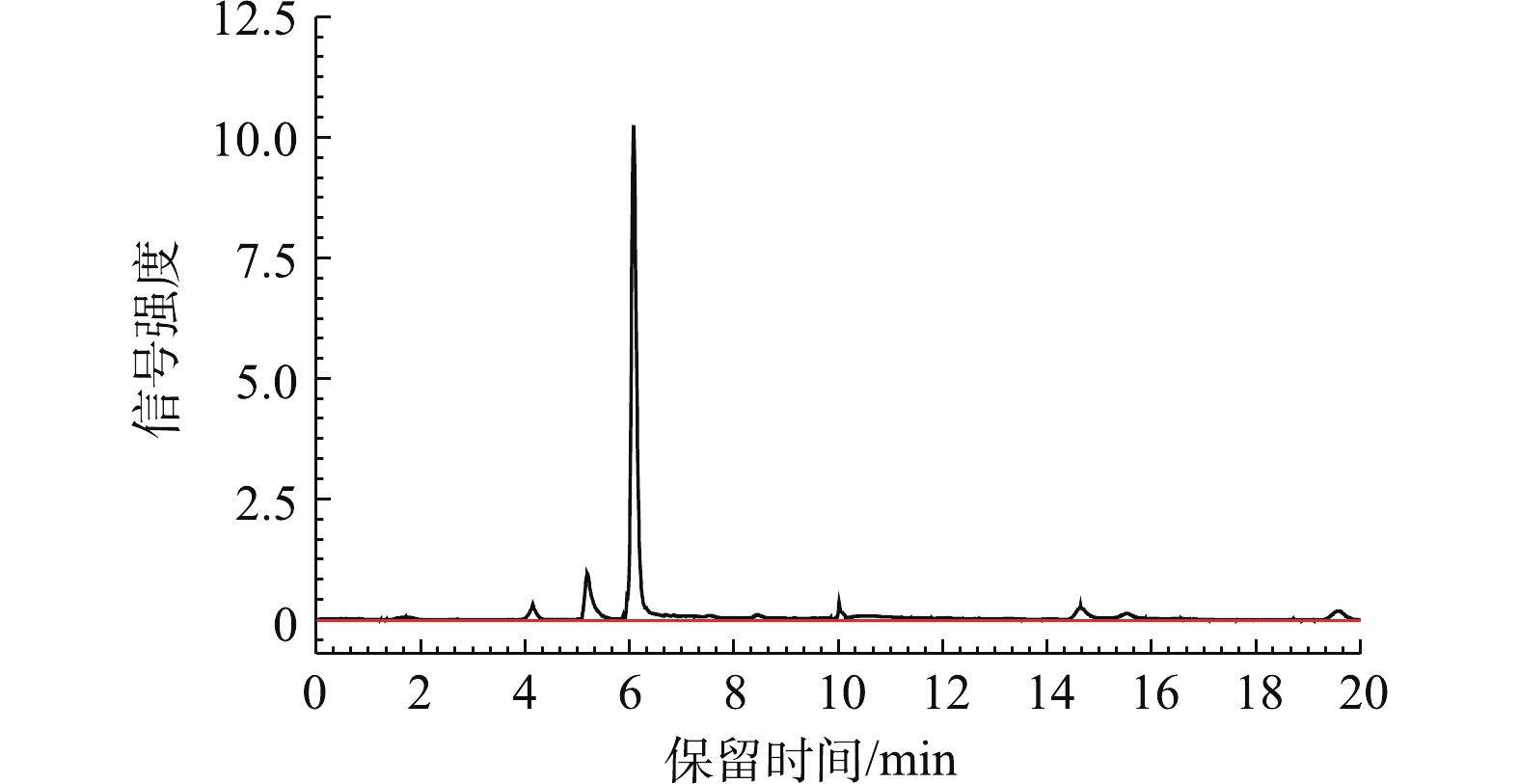-
磺胺(sulfonamide,SA)类药物是第一类人工合成的抗菌药,用于临床已有80多年[1],它具有抗菌谱广、性质稳定、使用简便等优点[2]。临床常用的磺胺类药物在合成生产过程中会产生较大量的含有苯磺酰胺、苯磺酸、苯酚等物质的磺胺类制药废水,须在排放前进行有效处理。然而,磺胺类制药废水含有多种结构较稳定的苯系物,导致该废水的处理难度较大。当前污水处理厂对磺胺类制药废水的处理主要采用Fenton氧化法[3]、矿物材料吸附法[4]、活性污泥降解法[5]等,但是处理效果并不理想[6-7],一些未被有效处理的残余药物不可避免地随出水进入自然环境。苯为环境中主要的有毒有机污染物之一[8],已被世界卫生组织列为一类致癌物,苯酚和苯磺酸的毒性与苯相似,容易经呼吸道和皮肤进入人体,抑制中枢神经系统[9],残留的苯磺酰胺进入自然水体,对生态环境和人类健康构成潜在威胁[10-11]。因此,针对磺胺类制药废水中广泛含有的苯磺酰胺、苯磺酸、苯酚等物质,构建一种有效的快速同步检测方法,对于评价废水处理效能、环境污染评价和预警具有重要的意义。
目前,单独检测苯磺酰胺、苯磺酸、苯酚的方法[12-17]已有报道,但针对同时含有这3种苯系物组分的磺胺类制药废水,单一样品的检测方法存在水样预处理步骤繁琐、检测时效性低、检测成本高等问题,而目前尚未有快速同步检测这3种苯系物的方法。因此,本研究利用高效液相色谱仪,对比乙腈/水、甲醇/水和甲醇/缓冲盐3种流动相,调整230、240、250和260 nm 4种检测波长,建立了对磺胺类制药废水中苯磺酰胺、苯磺酸、苯酚等苯系物快速同步检测方法,为高效快捷地检测水样中苯系物的浓度和分布提供了便利。
-
仪器:高效液相色谱仪(HPLC,Primaide,HITACHI),配有UV-vis检测器(Primaide 1410),波长为200~700 nm;色谱柱型号为HITACHI LaChrom C18(5 μm,250 mm×4.6 mm);溶剂抽滤装置(1 000 mL,NALGENE)。
试剂:苯磺酸、苯酚、苯磺酰胺(色谱纯99.99%,Sigma-Aldrich);甲醇、乙腈(HPLC级,美国Fisher公司);超纯水(MilliQ,电阻率≥18 MΩ·cm);磷酸二氢铵(色谱纯99.99%,Macklin);100 mg·L−1苯磺酸、苯酚、苯磺酰胺标准储备液;100 mg·L−1混合标准使用液;5%的磷酸盐溶液。
-
苯环结构共轭体系中π跃迁至π*,在紫外吸收光区产生3个特征吸收带:强度较高的E1带分布在180~184 nm,中等强度的E2带分布在200~204 nm,强度较弱的B带分布在230~270 nm。
苯环上取代基类型及位置的不同都可能影响最大吸收峰的波长、强度和形状,在200~700 nm处进行全波长扫描,通过吸收光谱图发现,苯酚在270 nm处有较强吸收峰,苯磺酸在208 nm处有较强吸收峰,苯磺酰胺在240 nm处有较强吸收峰,因此,初次选择样品的检测波长为240 nm。调整检测波长230、250、260 nm,发现当检测波长为250 nm时,主要特征峰的相对保留峰面积最大,信号强度最明显。色谱柱恒温箱设为30 ℃;进样量为20 μL;柱温为30 ℃;为减小柱压过高对色谱柱造成的损伤,设定流速为0.6 mL·min−1。
-
孙佳慧等[16-17]在使用液相色谱检测水中极性有机物时,常用乙腈-水、甲醇-水、甲醇-磷酸体系作为流动相。苯酚、苯磺酸和苯磺酰胺3种物质均为极性化合物,先采用乙腈和水作为流动相,改用极性较弱的甲醇和水作流动相,再用甲醇和磷酸二氢铵溶液作为流动相,分别调整各流动相体系中不同溶剂的配比,其他检测条件相同。结果表明,采用乙腈-水流动相条件,主峰与杂峰连在一起,见图1(a);采用甲醇-水流动相条件,即使调整了甲醇的配比,仍然出现了保留值重现性差和峰拖尾的现象,见图1(b);采用甲醇-磷酸二氢铵流动相条件,磷酸盐过量的添加会造成特征峰的相对保留时间变长,分析时间延长,管路系统堵塞,当V甲醇∶V磷酸二氢铵=50∶50时,各个物质的特征峰分离效果好,峰形尖锐,无基线飘移的现象,主要有3个特征峰,5.220 min处为苯磺酸特征峰,6.047 min处为苯磺酰胺特征峰,10.007 min处为苯酚特征峰,得到3种苯系物色谱(见图1(c))。以上研究结果表明,本研究可选择甲醇-磷酸二氢铵溶液作为流动相体系。
-
1) 精密度的测定。分析结果的相对标准偏差(R)检验方法精密度的计算方法如式(1)和式(2)所示。
式中:S为标准偏差;
Xi 为第i次测量值;ˉX 为n次测量值的平均值;n为试样总数或测量次数。按照设定的色谱条件吸取混合溶液20 μL,进行单样品分析,重复进样5次,测定不同物质特征峰的相对保留时间和峰面积,苯磺酸特征峰相对保留时间的R为0.10%,相对峰面积的R为1.04%,苯磺酰胺特征峰相对保留时间的R为0.05%,相对峰面积的R为0.25%,苯酚特征峰相对保留时间的R为0.09%,相对峰面积的R为0.82%,R均小于5%,说明该方法的检测精密度高[18]。
2)重现性的测定。从同一混合溶液中分别抽取5份,按照设定的色谱条件进行样品的连续分析,平行样品特征峰的相对保留时间和峰面积稳定,波动较小。其中,苯磺酸特征峰相对保留时间的R为0.16%,相对峰面积的R为1.12%;苯磺酰胺特征峰相对保留时间的R为0.06%,相对峰面积的R为0.46%;苯酚特征峰相对保留时间的R为0.09%,相对峰面积的R为1.56%,R均小于5%,以上结果表明该方法的重现性好[18]。
3)标准曲线与检出限。配制浓度为5、10、20、40、80、100 mg·L−1的标准混合溶液样品,通过高效液相色谱仪进行分析,单一样品进样3次,检测3种物质特征峰的峰面积并计算平均值,以特征峰的峰面积为横坐标,以物质的浓度C为纵坐标,绘制标准曲线,标准曲线见图2。结果显示,3种目标物色谱峰面积与浓度均表现出良好的线性相关性(R2>0.999)。高效液相色谱分析方法中,一般以基线噪声的3~5倍作为样品的检出限,根据仪器噪声信号强度的大小确定苯磺酸的检出限为29.4 μg·L−1,苯磺酰胺的检出限为22.3 μg·L−1,苯酚的检出限为15.0 μg·L−1。
-
应用本研究建立的分析方法对采自北京市某制药厂生产废水水样进行测定,首先将水样用0.22 μm滤膜过滤,稀释至适宜浓度(浓度为5~100 mg·L−1),取1.0 mL过膜稀释后的水样,加入到液相,用小瓶进行HPLC检测。3种物质均有不同浓度的检出,得到的液相色谱如图3所示,其中浓度最高的为苯磺酰胺(24.85 mg·L−1),其次为苯磺酸(2.81 mg·L−1),苯酚(0.63 mg·L−1)最低。取1 L水样加入苯磺酸标准品5 mg,连续分析3次,结果显示苯磺酸的加标回收率为102.0%;另取相同体积水样,加入苯磺酰胺标准品25 mg,连续分析的结果显示苯磺酰胺的加标回收率为97.1%;再取相同水样,加入苯酚标准品1 mg,连续分析的结果显示苯酚的加标回收率为94.9%。
-
1)研究建立了一种可同步快速检测制药废水中的苯磺酸、苯酚和苯磺酰胺的方法。该方法能有效减少杂峰,其峰形尖锐、对称性好且特征峰之间分离效果较好,3种目标物可在11 min内分离开来。相对于传统方法[12, 15],无需样品前处理,有利于快速分析样品。相对标准偏差为0.05%~1.56%,精密度和准确度高,重复性好,线性范围宽,可达到检测要求。
2)应用所建立的方法对北京市某制药厂生产废水进行测定,发现该废水中苯磺酰胺浓度最高,检测结果受其他物质影响较小。
磺胺类制药废水中苯系物的快速同步检测
Rapid synchronous detection of benzene series in sulfonamide pharmaceutical wastewater
-
摘要: 磺胺类制药废水是一类难降解有机废水,其中含有苯磺酰胺、苯磺酸、苯酚等苯系物,对这些物质的快速检测十分必要,针对这3种物质建立了基于高效液相色谱的快速同步检测方法。采用C18柱为分离柱,比较了乙腈/水、甲醇/水和甲醇/缓冲盐3种流动相体系的分离效果,优化了230、240、250和260 nm 4种检测波长等条件。结果表明,V甲醇∶V磷酸二氢铵溶液(0.5%,pH=3.5)=50∶50作为流动相时,基线稳定,峰形较好,3种目标物在11 min内即可实现有效分离,且浓度为5~100 mg·L−1时,3种目标物峰面积与质量浓度的线性关系良好(R2>0.999),检出限为15.0~29.4 μg·L−1,相对偏差为0.05%~1.56%(n=5),该方法能同时检测苯磺酸、苯酚和苯磺酰胺,具有简便、灵敏、准确等优点,可为制药废水的快速检测和磺胺类药物降解机理的分析提供便利。Abstract: Sulfonamide pharmaceutical wastewater is a kind of refractory organic wastewater, which usually contains benzene series compounds e.g. benzenesulfonic acid, phenol and benzene. It is necessary to develop their fast detection methods. In this study, a rapid method for synchronous detection of benzenesulfonic acid, phenol and benzene sulfonamide in pharmaceutical wastewater was established based on high performance liquid chromatography. The reverse-phase C18 column was used, the separation effects of three mobile phase systems of acetonitrile/water, methanol/water and methanol/buffering salt were compared, and the four detection wavelengths of 230, 240, 250 and 260 nm was optimized. The results showed that the stable baseline and high-quality peak shape could be detected when Vmethanol∶Vammonium dihydrogen phosphate solution (0.5%, pH=3.5) = 50∶50 was used as the mobile phase, and the three target compounds could be well-separated within 11 min. Within the concentration range of 5~100 mg·L−1, good linear relationship between the peak area of the three targets and the mass concentration was achieved (R2>0.999). The detection limit and relative deviation were between 15.0~29.4 μg·L−1 and between 0.05%~1.56% (n=5), respectively. This method can effectively separate the three substances, and has the advantages of simplicity, sensitivity and accuracy. It can facilitate the fast detection of pharmaceutical wastewater and the analysis of the sulfonamides degradation mechanism.
-
磺胺(sulfonamide,SA)类药物是第一类人工合成的抗菌药,用于临床已有80多年[1],它具有抗菌谱广、性质稳定、使用简便等优点[2]。临床常用的磺胺类药物在合成生产过程中会产生较大量的含有苯磺酰胺、苯磺酸、苯酚等物质的磺胺类制药废水,需要在排放前进行有效处理。然而,磺胺类制药废水含有多种结构较稳定的苯系物,导致该废水的处理难度较大。当前污水处理厂对磺胺类制药废水的处理主要采用Fenton氧化法[3]、矿物材料吸附法[4]、活性污泥降解法[5]等,但是处理效果并不理想[6-7],不可避免的一些未被有效处理的残余药物随出水进入自然环境。苯为环境中主要的有毒有机污染物之一[8],已被世界卫生组织列为一类致癌物,苯酚和苯磺酸的毒性与苯相似,容易经呼吸道和皮肤进入人体,抑制中枢神经系统[9],残留的苯磺酰胺进入自然水体,对生态环境和人类健康构成潜在威胁[10-11]。因此,针对磺胺类制药废水中广泛含有的苯磺酰胺、苯磺酸、苯酚等物质,构建一种有效的快速同步检测方法对于评价废水处理效能、环境污染评价和预警具有重要的意义。
目前,单独检测苯磺酰胺、苯磺酸、苯酚的方法[12-17]已有报道,但针对同时含有这3种苯系物组分的磺胺类制药废水,单一样品的检测方法存在水样预处理步骤繁琐、检测时效性低、检测成本高等问题,而目前尚未有快速同步检测这3种苯系物的方法。因此,本研究利用高效液相色谱仪,对比乙腈/水、甲醇/水和甲醇/缓冲盐3种流动相,调整230、240、250和260 nm 4处检测波长,建立了对磺胺类制药废水中苯磺酰胺、苯磺酸、苯酚等苯系物快速同步检测方法,为高效快捷的检测水样中苯系物的浓度和分布提供了便利。
1. 实验部分
1.1 实验仪器与试剂
仪器:高效液相色谱仪(HPLC,Primaide,HITACHI),配有UV-Vis检测器(Primaide 1410),波长为200~700 nm;色谱柱型号为HITACHI LaChrom C18(5 μm,250 mm×4.6 mm);溶剂抽滤装置(1 000 mL,NALGENE)。
试剂:苯磺酸,苯酚,苯磺酰胺(色谱纯99.99%,Sigma-Aldrich);甲醇、乙腈(HPLC级,美国Fisher公司);超纯水(MilliQ,电阻率≥18 MΩ·cm);磷酸二氢铵(色谱纯99.99%,Macklin);100 mg·L−1苯磺酸、苯酚、苯磺酰胺标准储备液;100 mg·L−1混合标准使用液;5%的磷酸盐溶液。
1.2 色谱条件
苯环结构共轭体系中π跃迁至π*在紫外吸收光区产生3个特征吸收带:强度较高的E1带分布在180~184 nm,中等强度的E2带分布在200~204 nm,强度较弱的B带分布在230~270 nm。
苯环上取代基类型及位置的不同都可能影响最大吸收峰的波长、强度和形状,在200~700 nm进行全波长扫描,吸收光谱图发现,苯酚在270 nm处有较强吸收峰,苯磺酸在208 nm处有较强吸收峰,苯磺酰胺在240 nm处有较强吸收峰,因此初次选择样品的检测波长为240 nm。调整检测波长230、250、260 nm,发现当检测波长为250 nm时,主要特征峰的相对保留峰面积最大,信号强度最明显。色谱柱恒温箱设为30 ℃;进样量20 μL;柱温为30 ℃;为减小柱压过高对色谱柱造成损伤,设定流速为0.6 mL·min−1。
2. 结果与讨论
2.1 流动相体系的选择
孙佳慧等[16-17]在使用液相色谱检测水中极性有机物时,常用乙腈-水、甲醇-水、甲醇-磷酸体系作为流动相。苯酚、苯磺酸和苯磺酰胺3种物质均为极性化合物,先采用乙腈和水作为流动相,改用极性较弱的甲醇和水作流动相,再用甲醇和磷酸二氢铵溶液作为流动相,分别调整各流动相的体系中不同溶剂的配比,其他检测条件相同。结果表明,采用乙腈-水流动相条件下,主峰与杂峰连在一起,如图1(a)所示;采用甲醇-水流动相条件下,即使调整了甲醇的配比,仍然出现了保留值重现性差和峰拖尾的现象,如图1(b)所示;采用甲醇-磷酸二氢铵流动相条件下,磷酸盐过量的添加会造成特征峰的相对保留时间变长,分析时间延长,管路系统堵塞,当V甲醇∶V磷酸二氢铵=50∶50时,各个物质的特征峰分离效果好,峰形尖锐,无基线飘移的现象,主要共有3个特征峰,5.220 min处为苯磺酸特征峰,6.047 min处为苯磺酰胺特征峰,10.007 min处为苯酚特征峰,得到的3种苯系物色谱图如图1(c)所示。以上研究结果表明,本研究选择甲醇-磷酸二氢铵溶液作为流动相体系。
2.2 质量保证与控制实验
1) 精密度测定。通过分析结果的相对标准偏差(R)检验方法的精密度。计算公式如式(1)和式(2)所示。
S=√∑(Xi−ˉX)2n−1 (1) R=SˉX×100% (2) 式中:S为标准偏差;
Xi 为第i次测量值;ˉX 为n次测量值的平均值;n为试样总数或测量次数。按照设定的色谱条件吸取混合溶液20 μL,进行单样品分析,重复进样5次,测定不同物质特征峰的相对保留时间和峰面积,苯磺酸特征峰相对保留时间的R为0.10%,相对峰面积的R为1.04%,苯磺酰胺特征峰相对保留时间的R为0.05%,相对峰面积的R为0.25%,苯酚特征峰相对保留时间的R为0.09%,相对峰面积的R为0.82%,R均小于5%,说明该方法的检测精密度高[18]。
2)重现性测定。从同一混合溶液中分别抽取5份,按照设定的色谱条件进行样品的连续分析,平行样品特征峰的相对保留时间和峰面积稳定,波动较小。其中,苯磺酸特征峰相对保留时间的R为0.16%,相对峰面积的R为1.12%;苯磺酰胺征峰相对保留时间的R为0.06%,相对峰面积的R为0.46%;苯酚特征峰相对保留时间的R为0.09%,相对峰面积的R为1.56%,R均小于5%,以上结果表明该方法的重现性好[18]。
3)标准曲线与检出限。配制浓度为5,10,20,40,80,100 mg·L−1的标准混合溶液样品,通过高效液相色谱仪进行分析,单一样品进样3次,检测3种物质特征峰的峰面积并计算平均值,以特征峰的峰面积为横坐标,以物质的浓度C为纵坐标,绘制标准曲线,不同浓度对应的峰面积值见表1,标准曲线见图2。结果显示,3种目标物色谱峰面积与浓度均表现出良好的线性相关性(R2>0.999)。高效液相色谱分析方法中,一般以基线噪声的3~5倍作为样品的检出限,根据仪器噪声信号强度的大小确定苯磺酸的检出限为29.4 μg·L−1,苯磺酰胺的检出限为22.3 μg·L−1,苯酚的检出限为15.0 μg·L−1。
2.3 实际样品测定
应用本文建立的分析方法对采自北京市某制药厂生产废水水样进行测定,首先将水样用0.22 μm滤膜过滤,稀释至适宜浓度(浓度为5~100 mg·L−1),取1.0 mL过膜稀释后的水样加入到液相用小瓶进行HPLC检测。3种物质均有不同浓度的检出,得到的液相色谱图如图3所示,其中浓度最高的为苯磺酰胺(24.85 mg·L−1),其次为苯磺酸(2.81 mg·L−1),苯酚(0.63 mg·L−1)最低。取1 L水样加入苯磺酸标准品5 mg,连续分析3次,结果显示苯磺酸的加标回收率为102.0%;另取相同体积水样,加入苯磺酰胺标准品25 mg,连续分析的结果显示苯磺酰胺的加标回收率为97.1%;再取相同水样,加入苯酚标准品1 mg,连续分析的结果显示苯酚的加标回收率为94.9%。
3. 结论
1)研究建立了1种可同步快速检测制药废水中的苯磺酸、苯酚和苯磺酰胺的方法。该方法能有效减少杂峰,其峰形尖锐、对称性好且特征峰之间分离效果较好,3种目标物可在11 min内可分离开来。相对于传统方法[12, 15],无需样品前处理,有利于快速分析样品。相对标准偏差为0.05%~1.56%,精密度和准确度高、重复性好、线性范围宽,可达到检测要求。
2)应用所建立的方法对北京市某制药厂生产废水进行了测定,结果表明,该废水中苯磺酰胺浓度最高,检测结果受其他物质影响较小。
-
[1] 何世超, PONMANI J, AVULA S R, 等. 磺胺类药物化学研究新进展[J]. 中国科学(化学), 2016, 46(9): 823-847. [2] 王佳丽. 地下水中磺胺类抗生素降解菌及附载材料研究[D]. 长春: 吉林大学, 2017. [3] 符荷花, 陈猛, 熊小京. Fenton氧化法对磺胺类抗生素的降解动力学[J]. 环境工程学报, 2014, 8(3): 972-976. [4] 王佳丽, 张玉玲, 钱红, 等. 吸附法去除低温水体中的磺胺类抗生素[J]. 吉林大学学报(理学版), 2016, 54(3): 663-669. [5] YU T H, LIN Y C, LATEEF S K, et al. Removal of antibiotics and non-steroidal anti-inflammatory drugs by extended sludge age biological process[J]. Chemosphere, 2009, 77(2): 175-181. doi: 10.1016/j.chemosphere.2009.07.049 [6] 甘秀梅, 严清, 高旭, 等. 典型抗生素在中国西南地区某污水处理厂中的行为和归趋[J]. 环境科学, 2014, 35(5): 1817-1823. [7] 柴玉峰, 张玉秀, 陈梅雪, 等. 冀西北典型北方小城镇污水处理厂中抗生素的分布和去除[J]. 环境科学, 2018, 39(6): 2724-2731. [8] VIOLANTE F S, SANGUINETTI G, BARBIERI A, et al. Lack of correlation between environmental or biological indicators of benzene exposure at parts per billion levels and micronuclei induction[J]. Environmental Research, 2003, 91(3): 135-142. doi: 10.1016/S0013-9351(02)00060-9 [9] 王兵, 刘璞真, 任宏洋, 等. 非均相催化臭氧化降解水中苯酚动力学[J]. 环境工程学报, 2016, 10(7): 3427-3433. doi: 10.12030/j.cjee.201502015 [10] PADHYE L P, YAO H, KUNG U F T, et al. Year-long evaluation on the occurrence and fate of pharmaceuticals, personal care products, and endocrine disrupting chemicals in an urban drinking water treatment plant[J]. Water Research, 2014, 51: 266-276. doi: 10.1016/j.watres.2013.10.070 [11] XU J, XU Y, WANG H M, et al. Occurrence of antibiotics and antibiotic resistance genes in a sewage treatment plant and its effluent-receiving river[J]. Chemosphere, 2015, 119: 1379-1385. doi: 10.1016/j.chemosphere.2014.02.040 [12] 朱薇. 分光光度法快速测定水中苯酚[J]. 环境科学与管理, 2010, 35(9): 145-147. doi: 10.3969/j.issn.1673-1212.2010.09.037 [13] 张宏森, 周国江, 周扬, 等. 焦化废水中苯酚含量的测定方法研究[J]. 中国给水排水, 2012, 28(16): 103-105. doi: 10.3969/j.issn.1000-4602.2012.16.029 [14] 王瑜, 臧伯安, 叶前进, 等. 循环伏安法检测水中苯酚浓度[J]. 化工技术与开发, 2018, 47(11): 37-40. doi: 10.3969/j.issn.1671-9905.2018.11.012 [15] 范志庆, 宋玉栋, 周岳溪. 离子色谱法测定丙烯酸丁酯生产废水中丙烯酸和对甲基苯磺酸[J]. 中国环境监测, 2010, 26(3): 29-32. doi: 10.3969/j.issn.1002-6002.2010.03.008 [16] 林梦勇. 高效液相色谱法测定面粉中苯磺酰胺[J]. 质量技术监督研究, 2014(6): 9-10. doi: 10.3969/j.issn.1674-5981.2014.06.003 [17] 孙家慧. 高效液相色谱法检测格列本脲中间体苯磺酰胺[J]. 天津化工, 2011, 25(6): 57-58. doi: 10.3969/j.issn.1008-1267.2011.06.022 [18] 吴蔓莉, 时艺馨, 李炜, 等. 高效液相色谱-二极管紫外阵列/荧光串联测定雌激素的方法及污水处理厂对雌激素的去除特性[J]. 环境工程学报, 2017, 11(4): 2614-2620. doi: 10.12030/j.cjee.201510228 期刊类型引用(1)
1. 李永琦,张弓,肖峰,龙国庆,张世浪,杨永飞. 天然矿石催化非均相芬顿反应降解苯酚. 环境工程学报. 2021(07): 2265-2273 .  本站查看
本站查看
其他类型引用(0)
-







 下载:
下载:






